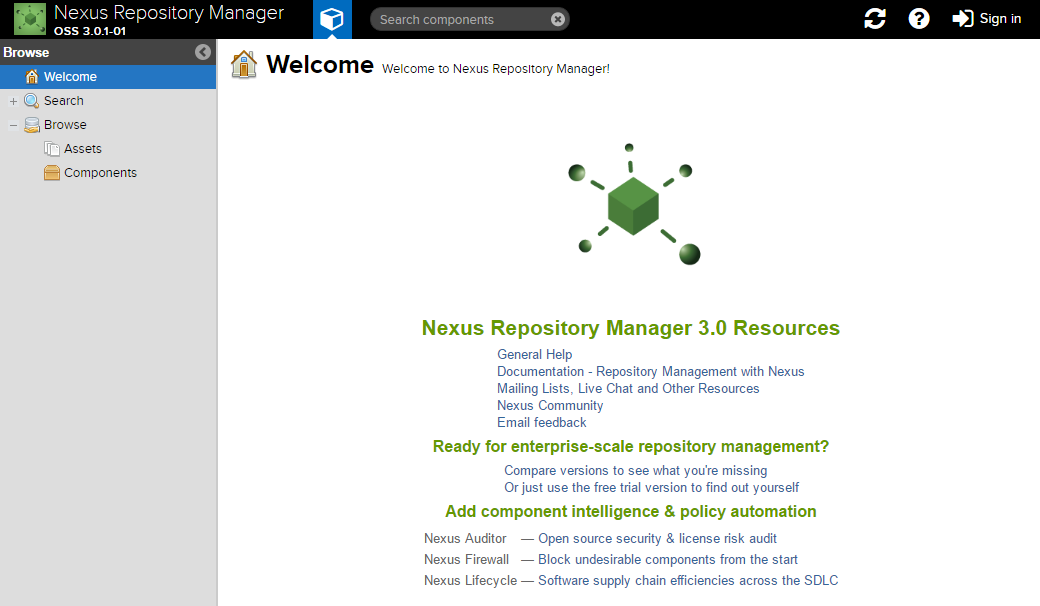Nexus是一个强大的仓库管理器,极大地简化了内部仓库的维护和外部仓库的访问。
2016年4月6日Nexus 3.0版本发布,相较2.x版本有了很大的改变:
对低层代码进行了大规模重构,提升性能,增加可扩展性以及改善用户体验。
升级界面,极大的简化了用户界面的操作和管理。
提供新的安装包,让部署更加简单。
增加对Docker, NeGet, npm, Bower的支持。
提供新的管理接口,以及增强对自动任务的管理。
安装
环境要求
Windows / Linux / Mac
Java JDK 8+
Apache Maven 3.0+
安装步骤
示例基于Ubuntu 16.04 LTS环境,安装前检查JDK:
nexus@ubuntu:~$ java -version
java version "1.8.0_91"
Java(TM) SE Runtime Environment (build 1.8.0_91-b14)
Java HotSpot(TM) 64-Bit Server VM (build 25.91-b14, mixed mode)1. 创建管理用户
该步骤不是必须的,但为了更好的管理和维护,建议创建一个管理用户。
# 使用root权限创建一个用户
root@ubuntu:~# adduser nexus
## 给nexus用户添加sudo权限
# 1. 给root写的权限
root@ubuntu:~# chmod u+w /etc/sudoers
# 2. 编辑/etc/sudoers,在root下添加nexus用户权限
nexus ALL=(ALL) ALL
# 3. 保存后撤回写的权限
root@ubuntu:~# chmod u-w /etc/sudoers2. 下载安装包
root@ubuntu:~# su nexus
nexus@ubuntu:~$ wget https://sonatype-download.global.ssl.fastly.net/nexus/3/nexus-3.0.1-01-unix.tar.gz
nexus@ubuntu:~$ ls
nexus-3.0.1-01-unix.tar.gz3. 解压和安装
nexus@ubuntu:~$ tar -zxvf nexus-3.0.1-01-unix.tar.gz
# 查看安装目录
nexus@ubuntu:~$ ls nexus-3.0.1-01/
bin data deploy etc lib LICENSE.txt NOTICE.txt public system
# bin: 启动脚本和启动时的配置文件
# data: 数据存储目录
# etc: 配置文件
# lib: Apache Karaf的二进制包
# public: 公共资源
# system: 系统依赖的组件和插件
# 指定JDK版本(可选)
nexus@ubuntu:~$ vim nexus-3.0.1-01/bin/nexus
INSTALL4J_JAVA_HOME_OVERRIDE="/usr/lib/jvm/java-8-oracle"
# 修改使用的用户(不建议使用root用户)
nexus@ubuntu:~/nexus-3.0.1-01$ vim bin/nexus.rc
run_as_user="nexus"4. 运行
nexus@ubuntu:~$ ./nexus-3.0.1-01/bin/nexus start
# 可选的命令:{start|stop|run|run-redirect|status|restart|force-reload}5. 验证安装
打开浏览器输入:http://127.0.0.1:8081
配置
以下配置均为可选,更详细的配置请查看官方文档
1. JVM配置(可选)
Nexus 3.0 的默认配置:
nexus@ubuntu:~$ cat nexus-3.0.1-01/bin/nexus.vmoptions
-Xms1200M
-Xmx1200M
-XX:+UnlockDiagnosticVMOptions
-XX:+UnsyncloadClass
-Djava.net.preferIPv4Stack=true
-Dkaraf.home=.
-Dkaraf.base=.
-Dkaraf.etc=etc
-Djava.util.logging.config.file=etc/java.util.logging.properties
-Dkaraf.data=data
-Djava.io.tmpdir=data/tmp
-Dkaraf.startLocalConsole=false修改JVM配置:
请根据系统实际情况配置
其他的JVM参数也可以添加到这里
-Xms1500M
-Xmx2G2. 配置端口号(可选,推荐为默认端口号:8081)
nexus@ubuntu:~$ vim nexus-3.0.1-01/etc/org.sonatype.nexus.cfg
application-port=9081重启后访问:http://localhost:9081
3. 配置数据存储目录(可选)
nexus@ubuntu:~$ vim nexus-3.0.1-01/bin/nexus.vmoptions
# 默认存储目录
-Dkaraf.data=data
-Djava.io.tmpdir=data/tmp4. 配置代理(可选)
Apache httpd.
ProxyRequests Off
ProxyPreserveHost On
<VirtualHost: *:80>
ServerName www.example.com
ServerAdmin admin@example.com
ProxyPass /nexus http://localhost:8081/
ProxyPassReverse / http://localhost:8081/
ErrorLog logs/nexus/error.log
CustomLog logs/nexus/access.log common
</VirtualHost>nginx.
http {
proxy_send_timeout 120;
roxy_read_timeout 300;
proxy_buffering off;
keepalive_timeout 5 5;
tcp_nodelay on;
server {
listen *:80;
server_name www.example.com;
# allow large uploads of files - refer to nginx documentation
client_max_body_size 1G
# optimize downloading files larger than 1G - refer to nginx doc before adjusting
# proxy_max_temp_file_size 2G
location /nexus {
proxy_pass http://localhost:8081/nexus;
proxy_set_header Host $host;
proxy_set_header X-Real-IP $remote_addr;
proxy_set_header X-Forwarded-For
$proxy_add_x_forwarded_for;
}
}
}5. 配置SSL(可选)
Apache httpd. Ensure Apache httpd is loading mod_ssl.
Listen 443
ProxyRequests Off
ProxyPreserveHost On
<VirtualHost *:443>
SSLEngine on
SSLCertificateFile "example.pem"
SSLCertificateKeyFile "example.key"
ServerName repo.example.com
ServerAdmin admin@example.com
ProxyPass / http://localhost:8081/
ProxyPassReverse / http://localhost:8081/
RequestHeader set X-Forwarded-Proto "https"
ErrorLog logs/repo.example.com/nexus/error.log
CustomLog logs/repo.example.com/nexus/access.log common
</VirtualHost>nginx. Make sure nginx is compiled using the --with-http_ssl_module option.
http {
proxy_send_timeout 120;
proxy_read_timeout 300;
proxy_buffering off;
keepalive_timeout 5 5;
tcp_nodelay on;
server {
listen *:443;
server_name repo.example.com;
# allow large uploads of files - refer to nginx documentation
client_max_body_size 1G
# optimize downloading files larger than 1G - refer to nginx doc before adjusting
#proxy_max_temp_file_size 2G
ssl on
ssl_certificate example.pem;
ssl_certificate_key example.key;
location / {
proxy_pass http://localhost:8081/;
proxy_set_header Host $host;
proxy_set_header X-Real-IP $remote_addr;
proxy_set_header X-Forwarded-For ←-
$proxy_add_x_forwarded_for;
proxy_set_header X-Forwarded-Proto "https";
}
}
}仓库介绍
1. 代理仓库(Proxy Repository)
顾名思义是代理第三方仓库的,如:
maven-central
nuget.org-proxy
版本策略(Version Policy):
Release: 正式版本
Snapshot: 快照版本
Mixed: 混合模式
布局策略(Layout Policy):
Strict:严格
Permissive:宽松
2. 宿主仓库(Hosted Repository)
存储本地上传的组件和资源的,如:
maven-releases
maven-snapshots
nuget-hosted
部署策略(Deployment Policy):
Allow Redeploy:允许重新部署
Disable Redeploy:禁止重新部署
Read-Only:只读
3. 仓库组(Repository Group)
通常包含了多个代理仓库和宿主仓库,在项目中只要引入仓库组就可以下载到代理仓库和宿主仓库中的包,如:
maven-public
nuget-group
用户界面的操作和管理相对简单,请参考官方文档
与Maven集成
1. Servers 配置认证信息
在Maven settings.xml中添加Nexus认证信息:
<server>
<id>nexus-releases</id>
<username>admin</username>
<password>admin123</password>
</server>
<server>
<id>nexus-snapshots</id>
<username>admin</username>
<password>admin123</password>
</server>nexus-releases: 用于发布Release版本
nexus-snapshots: 用于发布Snapshot版本
Release版本与Snapshot版本的区分:
Release: 4.3.0
Snapshot: 4.3.0-SNAPSHOT在项目POM.xml中设置的版本号添加SNAPSHOT标识的都会发布为SNAPSHOT版本,没有SNAPSHOT标识的都会发布为Release版本。
SNAPSHOT版本会自动加一个时间作为标识,如:
4.3.0-SNAPSHOT发布后为变成4.3.0-SNAPSHOT-20160712.114532-1.jar
2. 配置自动化部署构件
在POM.xml中添加以下代码:
<distributionManagement>
<repository>
<id>nexus-releases</id>
<name>Nexus Release Repository</name>
<url>http://127.0.0.1:8081/repository/maven-releases/</url>
</repository>
<snapshotRepository>
<id>nexus-snapshots</id>
<name>Nexus Snapshot Repository</name>
<url>http://127.0.0.1:8081/repository/maven-snapshots/</url>
</snapshotRepository>
</distributionManagement> 注意事项:
ID名称必须要与settings.xml中Servers配置的ID名称保持一致。
项目版本号中有SNAPSHOT标识的,会发布到Nexus Snapshots Repository, 否则发布到Nexus Release Repository,并根据ID去匹配授权账号。
3. 部署到Nexus仓库
mvn deploy4. 上传第三方JAR包
Nexus 3.0不支持页面上传,可使用maven命令:
# 如第三方JAR包:aliyun-sdk-oss-2.2.3.jar
mvn deploy:deploy-file
-DgroupId=com.aliyun.oss
-DartifactId=aliyun-sdk-oss
-Dversion=2.2.3
-Dpackaging=jar
-Dfile=D:\aliyun-sdk-oss-2.2.3.jar
-Durl=http://127.0.0.1:8081/repository/maven-3rd/
-DrepositoryId=nexus-releases注意事项:
建议在上传第三方JAR包时,创建单独的第三方JAR包管理仓库,便于管理有维护。(maven-3rd)
-DrepositoryId=nexus-releases对应的是settings.xml中Servers配置的ID名称。(授权)
5. 使用代理中央仓库
<repositories>
<repository>
<id>nexus</id>
<name>Nexus Repository</name>
<url>http://127.0.0.1:8081/repository/maven-public/</url>
<snapshots>
<enabled>true</enabled>
</snapshots>
<releases>
<enabled>true</enabled>
</releases>
</repository>
</repositories>
<pluginRepositories>
<pluginRepository>
<id>nexus</id>
<name>Nexus Plugin Repository</name>
<url>http://127.0.0.1:8081/repository/maven-public/</url>
<snapshots>
<enabled>true</enabled>
</snapshots>
<releases>
<enabled>true</enabled>
</releases>
</pluginRepository>
</pluginRepositories>注意事项:
在开发中如果有严格的管理要求,可将SNAPSHOT和RELEASE单独配置。
有插件依赖时配置插件仓库,默认会使用Maven中央仓库。


**粗体** _斜体_ [链接](http://example.com) `代码` - 列表 > 引用。你还可以使用@来通知其他用户。